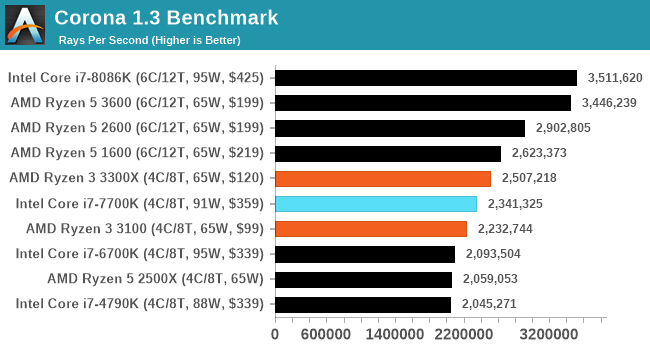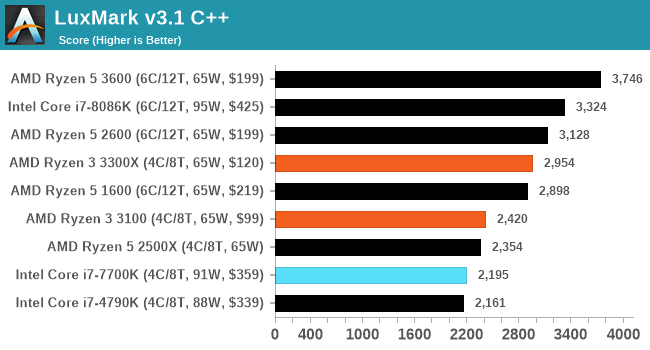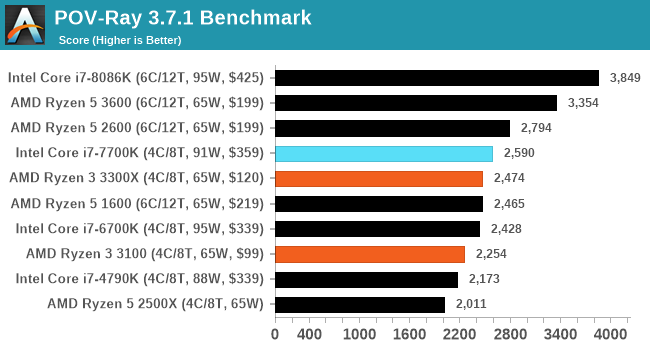The AMD Ryzen 3 3300X and 3100 CPU Review: A Budget Gaming Bonanza
by Dr. Ian Cutress on May 7, 2020 9:00 AM ESTCPU Performance: Rendering Tests
Rendering is often a key target for processor workloads, lending itself to a professional environment. It comes in different formats as well, from 3D rendering through rasterization, such as games, or by ray tracing, and invokes the ability of the software to manage meshes, textures, collisions, aliasing, physics (in animations), and discarding unnecessary work. Most renderers offer CPU code paths, while a few use GPUs and select environments use FPGAs or dedicated ASICs. For big studios however, CPUs are still the hardware of choice.
All of our benchmark results can also be found in our benchmark engine, Bench.
Corona 1.3: Performance Render
An advanced performance based renderer for software such as 3ds Max and Cinema 4D, the Corona benchmark renders a generated scene as a standard under its 1.3 software version. Normally the GUI implementation of the benchmark shows the scene being built, and allows the user to upload the result as a ‘time to complete’.
We got in contact with the developer who gave us a command line version of the benchmark that does a direct output of results. Rather than reporting time, we report the average number of rays per second across six runs, as the performance scaling of a result per unit time is typically visually easier to understand.
The Corona benchmark website can be found at https://corona-renderer.com/benchmark

LuxMark v3.1: LuxRender via Different Code Paths
As stated at the top, there are many different ways to process rendering data: CPU, GPU, Accelerator, and others. On top of that, there are many frameworks and APIs in which to program, depending on how the software will be used. LuxMark, a benchmark developed using the LuxRender engine, offers several different scenes and APIs.
In our test, we run the simple ‘Ball’ scene on both the C++ and OpenCL code paths, but in CPU mode. This scene starts with a rough render and slowly improves the quality over two minutes, giving a final result in what is essentially an average ‘kilorays per second’.

POV-Ray 3.7.1: Ray Tracing
The Persistence of Vision ray tracing engine is another well-known benchmarking tool, which was in a state of relative hibernation until AMD released its Zen processors, to which suddenly both Intel and AMD were submitting code to the main branch of the open source project. For our test, we use the built-in benchmark for all-cores, called from the command line.
POV-Ray can be downloaded from http://www.povray.org/












249 Comments
View All Comments
Spunjji - Monday, May 11, 2020 - link
What a worthless comment. Sure, they included high-end Intel CPUs in the gaming sections - but the review isn't *about* high-end CPUs, it's about what you get for the money with these specific AMD CPUs. Comparing AMD's budget gaming CPU to the best available to see how little you lose is a valid comparison to make.jjjag - Tuesday, May 12, 2020 - link
Anandtech can no longer write a simple factual article anymore about any processor. Even this article, which is supposed to be a simple article about a new low-cost processor, uses the word "Bonanza" in the title, mysteriously It also takes multiple jabs at Intel in the body, even though it servers no purpose to the actual content. Every Anand article is now an opinion piece instead of responsible reporting.Spunjji - Tuesday, May 12, 2020 - link
"I hate content with flavour. I want lists of graphs with no words."Good for you. Off you go to userbenchmark, for worthless, context-free information that's appropriately biased towards your preferred team.
rdgoodri - Friday, May 15, 2020 - link
Its pretty positive for AMD, don't catch your angle here.Meteor2 - Tuesday, August 4, 2020 - link
This article absolutely rips into Intel, and rightly so.Your comment is bizarre.
PeterCollier - Thursday, May 7, 2020 - link
And what's the point of these new benchmarks? I prefer PCMark and Userbench. Basically no one is using their new CPU to simulate the neurons of a sea slug, for example. Utterly irrelevant to real-life usage.Mansoor - Thursday, May 7, 2020 - link
The purpose of a benchmark is to produce repeatable and reliable numbers. Just "doing real-life stuff" is not repeatable and will generate different numbers for everyone. If you have a specific use case in mind, you can observe relevant or related benchmarks.PeterCollier - Friday, May 8, 2020 - link
None of my use cases mesh with any of the lousily selected benchmarks in this review.Korguz - Friday, May 8, 2020 - link
then why are you here reading this article ?PeterCollier - Saturday, May 9, 2020 - link
I read articles from all sources, including the silicon-equivalent of Faux News. I find it a good practice to read from sources that you disagree with, or worse, purposely mislead you, because it's important not to create an echo chamber for one's self.